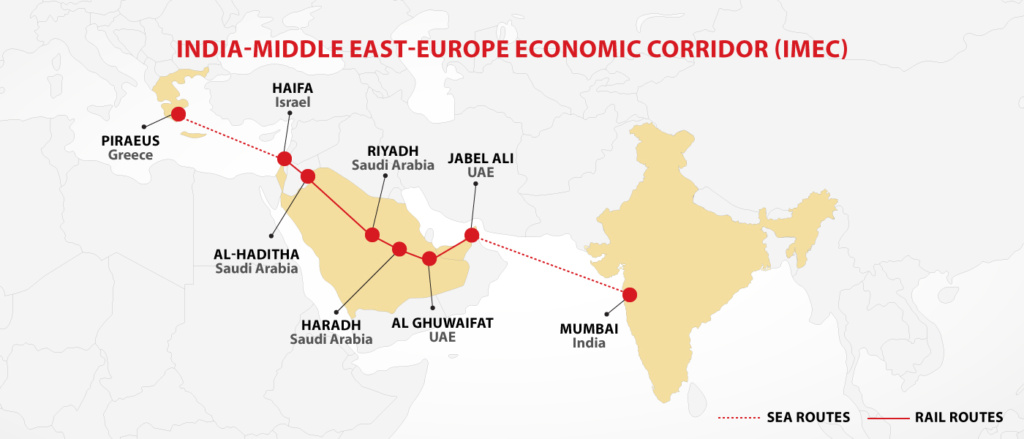Charting a New Era for Supply Chain Logistics: India-Middle East-Europe Economic Corridor
- September 28, 2023
- Blog
 In a historic milestone, several nations spanning continents have come together to mark the new creation of the IMEC (India – Middle East – Europe Economic Corridor). The Memorandum of Understanding (MoU) was unveiled at the G20 summit in New Delhi by the governments of India, Middle Eastern countries, Europe, and the United States, creating a major event in global economic and political dynamics.
In a historic milestone, several nations spanning continents have come together to mark the new creation of the IMEC (India – Middle East – Europe Economic Corridor). The Memorandum of Understanding (MoU) was unveiled at the G20 summit in New Delhi by the governments of India, Middle Eastern countries, Europe, and the United States, creating a major event in global economic and political dynamics.
The IMEC is a multi-continental rail and shipping route spread across two continents, and the member states are positive that it will increase economic development through enhanced connectivity, create jobs, reduce greenhouse emissions, and nurture economic integration among Asia, the Arabian Gulf and Europe. The IMEC corridor is expected to minimise the time and cost of transporting Indian goods to Europe by 40 to 30% and vice-versa.
What are the Key features of IMEC?
Dual Corridors: The IMEC will consist of two distinct corridors – the east corridor linking India to the Arabian Gulf and the northern corridor connecting the Arabian Gulf to Europe. It will also include a railway network project to complement existing maritime and road transport routes for cost-effective and quick cross-border ship-to-rail transportation, between India, the UAE, Jordan, Israel, Saudi Arabia and Europe.
Boosted Connectivity: The corridor will feature the development of electricity and global connectivity with pipelines for clean hydrogen export. This will help secure the regional supply chain and also upgrade trade accessibility and ease trade operations.
Economic Unity and Job Creation: With IMEC, world leaders want to improve economic efficiency, be cost-effective and bring economic unity among the participating nations. The whole process will generate job opportunities and contribute to the global goal of reducing greenhouse gas emissions.
Transformative Integration: The IMEC corridor, once completed will transform the economic landscape by seamlessly integrating Asia, Europe, and the Middle East, creating a corridor for trade and investment.
Challenges ahead
The MoU of IMEC doesn’t create obligations under international law. It only sets forth the political commitments of its participants which are non-binding. All member countries must meet periodically to develop and commit to an action plan with stipulated deadlines. The early groundbreaking of the project is a major challenge the corridor might face as finance plays a massive role considering the recession that has been creeping into the US and other advanced economies. The mobilisation of private sector finance will help to move ahead on the project as soon as possible.
The Conclusion
Once completed, it will be the face of a dependable and cost-effective ship-to-rail transit system for the cross-border movement of goods and services. The IMEC corridor will complement existing maritime and rail-road transport routes, such as the Suez Canal, North-South Transport Corridor, and China’s Silk Routes, enabling hassle-free transit between India, the UAE, Saudi Arabia, Jordan, Israel, and Europe.



